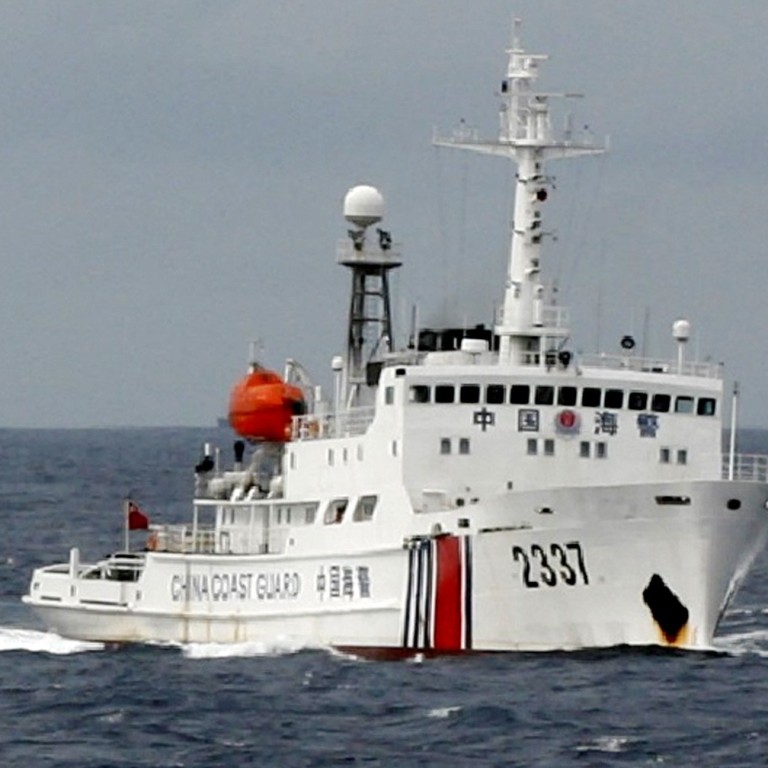
China Coast Guard heads to front line to enforce Beijing’s South China Sea claims
- The service’s role and integration with the military has been strengthened in the last year, leaving the navy to set sights on deeper waters
China is expected to use its coastguard fleet to shore up its paramilitary presence in the disputed South China Sea, using the personnel to strengthen law enforcement and even deter activities by other claimants, analysts said.
China has bolstered the coastguard’s role in the last year, bringing it under the control of the Central Military Commission and ordering it to be better prepared for trouble in the contested waters.
Addressing coastguard officers over the Lunar New Year, CMC vice-chairman Xu Qiliang said all personnel should be well prepared for different situations in the East China Sea – where China has competing claims with Japan – and the South China Sea.
Xu also urged them to “staunchly safeguard” China’s maritime rights and interests.
Adam Ni, a China researcher at Macquarie University in Sydney, said the China Coast Guard was “playing a key role in China’s unsettled sovereignty disputes by patrolling disputed waters to enforce China’s maritime claims”.
“[This] frees up the [People’s Liberation Army] Navy for power projection farther and farther from Chinese shores,” Ni said.
Beijing sends fleet of ships to disputed South China Sea island ‘to stop Philippines building facilities’
Xu’s rallying cry to the coastguard comes after a major restructure of the service last year that saw the State Oceanic Administration, which previously oversaw the coastguard with the Ministry of Public Security, merged with the Ministry of Natural Resources.
The coastguard then became part of the People’s Armed Police, which is directly under the CMC. The move was meant to improve the military’s coordination with maritime law enforcement, which was previously scattered across various agencies.
China has long wanted its coastguard fleet to be at the front line of enforcement in the troubled waters, leaving the navy to play a backup role.
But under the previous structure, the oceanic administration had no authority over the military, hampering coordination between the coastguard and navy.
The restructure ushered in a period of integration between the coastguard and navy, including a joint exercise between the Southern Theatre Command and the coastguard in August.
The navy has also transferred some of its officers to the coastguard, including Rear Admiral Wang Zhongcai, who became the coastguard’s commander in December. Wang previously took part in the navy’s mission in the Gulf of Aden, and was deputy chief of staff of the East Sea Fleet that was responsible for Taiwan, and the East China Sea.
In addition, Chinese navy and coastguard vessels were sent to Thitu in the Spratly chain as the Philippines built a beaching ramp on the island, according to satellite images provided by the Asia Maritime Transparency Initiative on Thursday.
There were 95 vessels in the waters at the peak of the confrontation on December 20, but the number dropped last month.
“The aggressive response of China is expected of them because it is what they have been doing in our territorial waters when we carry on with the construction plans in our own islands,” Philippine lawmaker Gary Alejano said.
“In several instances, Chinese military, coastguard and militia have employed the ‘cabbage strategy’ to intimidate our own forces and fishermen and encircle a disputed area. Like a cabbage, several Chinese vessels would surround our territories as they aim to intimidate our troops and to prevent us from having effective control over our islands.”
South China Sea: Trump military adviser calls for firmer rules to stop near misses
Collin Koh, a maritime research fellow at Nanyang Technological University in Singapore, said Xu’s Lunar New Year address signalled continued emphasis on civilian maritime law enforcement agencies such as the coastguard as the frontline force of choice in dealing with maritime flashpoints in those waters.
Koh said those law enforcement agencies were seen as less destabilising than naval forces.
“Deploying [the coastguard] on the front line is deemed less provocative at least in theory, though these days there’re questions or doubts raised as to whether this always holds true, since using coastguards could give cover to more aggressive actions in maritime flashpoints,” he said.
Retired PLA colonel Yue Gang said China would continue upgrading coastguard fleets and could use its new maritime rescue centre on Fiery Cross Reef to resupply vessels.
But Yue added that the United States was wary of such moves and had given coastguard vessels to other South China Sea claimants to counterbalance Beijing.
US Navy chief Admiral John Richardson has also called for tougher enforcement of rules against the Chinese coastguard.
Jin Yongming, director of the Shanghai Academy of Social Sciences’ Ocean Strategy Studies Centre, said the integration of the coastguard and military had made China’s handling of emergencies in the disputed waters more efficient, but coordination between the services was still inadequate.
“We have a structure and framework, but differentiation of duties is still not clearly defined,” he said.


